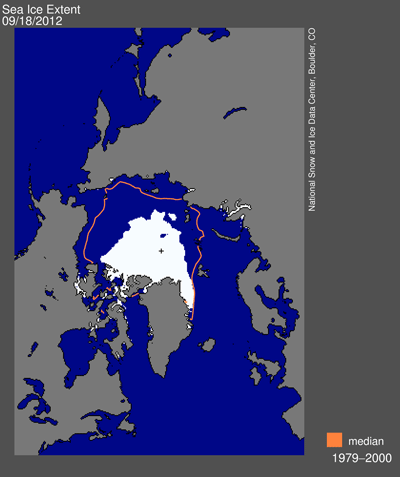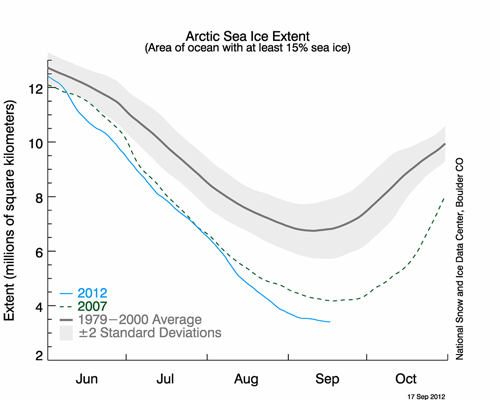Arctic Sea Ice at all time low – Key facts beyond headline
Arctic sea ice has an annual cycle. Each year the minimum ice is noted about the third week of September. Today it was announced that melting had reduced the polar ice sheet to 1.3 million sq miles (3.4 million skm). That is truly alarming, but not for the reason commonly believed. It has no direct effect on sea level rise. It is worth understanding why it is still very ominous.

Since it is floating it is very different than the two large ice sheets on top of Greenland and Antarctica (South Pole).
When floating sea ice melts it does not affect the level of liquid, similar to ice cubes floating in a glass of water.
The ice sheets and glaciers on land do add to sea level height as they melt and flow into the ocean, either as melt water or as icebergs, which eventually melt.
If you look at this satellite graphic the small plus sign in the middle of the white sea ice represents the North Pole. Alaska is at the 9 o’clock position and Norway about 4 o’clock just for orientation.
Each year the amount of ice varies depending on many factors, with average air temperature being a key element. The red line shows the average ice extent each September for the years 1979 – 2000, about two decades.
The current ice sheet is shown in white. It is 49% smaller than the average. Until now 2007 was the year with the greatest melt. This year now sets a new record with 18% ice than the 2007 record. The graph below shows the annual curve for the average year; for the previous record in 2007; and for this year through mid September
Here are the reasons for concern:
- The polar ice cap has been there for a little over three million years.
- The ice sheet is an important factor affecting the weather patterns that we take for granted.
- As the ice melts, turning from white to dark ocean, it changes the planets heat reflecting factor, going from almost 90% reflectance to as low as 10%. As the ocean absorbs more heat, the planet warms more, melting more ice — what scientists call a positive feedback loop.As the planet warms, the ice sheets of Greenland and Antartica will melt and raise sea level, so the melting Arctic Ocean will indirectly raise sea level but not immediately.
- While many think scientists are exagerating the warming problem, the Arctic ice cap proves the contrary. It is melting faster than any model has predicted.
- At the current rate of melting the Arctic Ocean will be ice free in September, as early as the year 2015, and perhaps as late as the year 2040.
- The melting and freezing of the ice sheets is a very long cycle, usually about 100,000 years.
- The models indicate that once the Arctic is ice free that we will not return to a solid sheet of multi year ice for at least a thousand years.
An open Arctic Ocean for a few months each year will open the fabled Northwest passage route for shipping. That may have some practical benefits. But the fact that the melting Arctic proves that the planet is warming beyond any doubt should be a real cause for concern.
Melting the huge ice sheets on Greenland and Antarctica will take centuries if not thousands of years. But when all the ice melts again, as it did tens of millions of years ago, sea level will be two hundred feet higher than today. That spells disaster for every coastal city in the world. It will be a very slow process and there is no imminent danger.
But this month’s record low sea ice confirms that the process is accelerating. Our growing level of greenhouse gases is now higher than in the last fifteen million years. If the trend continues the warming will increase.
If you would like to understand more, please look for my book High Tide On Main Street: Rising Sea Level and the Coming Coastal Crisis due out in last October or early November. For more information and to sign up for the publication announcement, please click here.

